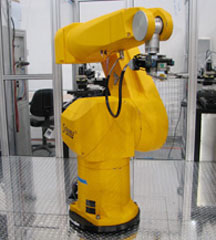

Scripps Florida Opens Its Cutting-Edge Screening Technology to Florida Scientists
Officials at Scripps Florida have announced the launch of the biomedical research institute's "Access to Technologies" program, which invites scientists from Florida universities and other academic research institutions to use state-of-the-art screening technologies at Scripps Florida's facilities in Jupiter for qualifying projects.
Access to Scripps Florida's new High Throughput Screening (HTS) operation, similar to that used widely by the pharmaceutical industry, should speed up the process of discovering new drugs to treat a variety of human illnesses.
"Inviting our state's outstanding scientists to share in the extraordinary technologies available at Scripps Florida is another example of how our investment in biomedical research is contributing to the biomedical knowledge base here," said Florida Governor Jeb Bush. "This program will pay off academically, economically, and ultimately lead to better health for Floridians and people everywhere."
"Science is always advanced through sharing," said Richard A. Lerner, president of the Scripps Florida's parent institution, The Scripps Research Institute in La Jolla, California. "I'm convinced that sharing our technologies with researchers throughout Florida will quicken the pace of progress, further challenging both them and us to find answers to difficult health questions."
Key components of the HTS process include the institute's cutting-edge screening system, purchased for Scripps Florida from Kalypsys of La Jolla, California, the first technology to be made available to academic scientists outside Scripps Florida or Scripps Research in California. These automated robots quickly determine and analyze the biological or biochemical activity of a large number of drug-like compounds, useful in discovering pharmacological targets or pharmacologically profiling a cellular or biochemical pathway of promise.
Typically, HTS assays are performed in sets of either 96 or 384 samples on each automation-friendly plate. The Scripps Florida technology can use plates that can hold up to 1,536 samples at a time, quickening the pace of analysis and discovery. The robots are two of only a handful of such machines in nonprofit research institutions. The facility also has several other robots that help scientists develop experiments suitable for the Kalypsys system.
Gaining Access to Scripps Florida Technologies
Florida researchers can begin the process by visiting the Scripps Florida Access to Technologies website, http://www.scripps.edu/florida/technologies/, which provides a description of the services available and instructions for completing a project submission form.
Scripps Florida scientists will evaluate each project for applicability to the HTS process, then notify the applicant of the project's status (approved, not approved, or further information required). Approved projects will then be scheduled, within the limits of time available for use of the technology and other resources. Once an institution's project is approved, the organization will be asked to complete appropriate agreements, submit materials, and begin the project.
At project completion, an electronic file containing the HTS data, and compound structures will be sent to the originating institution.
Send comments to: mikaono[at]scripps.edu

The Stäubli RX130L robotic arm makes up part of Scripps Florida's state-of-the-art screening technologies, now available to scientists at Florida universities and other academic research institutions.
